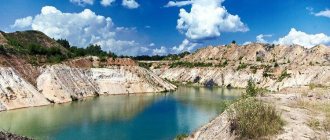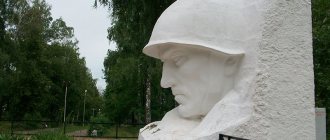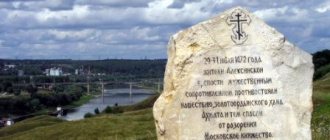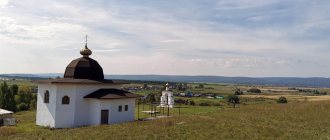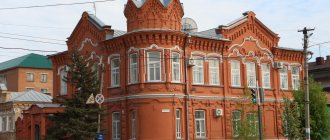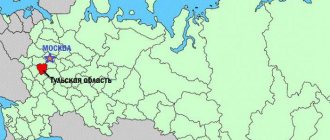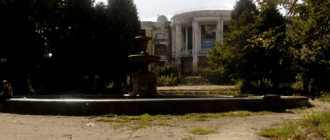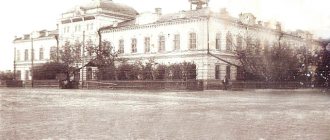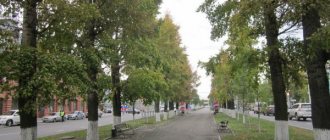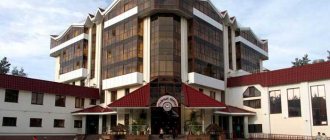In the central part of the East European Plain, on the Central Russian Upland, the small Tula region is located. The nature of this region is impressive with its splendor: clearings (stripes of forest) give way to river valleys, sandstones to lush greenery, and natural wonders to man-made monuments and tourist sites. It’s worth seeing the beautiful places of the Tula region at least once to understand: Russian people don’t need any foreign countries, because “over there” everything is foreign and cold, albeit beautiful, but here it’s our own, dear, real!
Quarries on the Sturgeon River
Byakovsky, or, in other words, Guryevsky, quarries are separate systems of underground passages stretching for a distance of 70 to 150 km along the bank of the Sturgeon River. Back in the 15th and 16th centuries, limestone was mined here by prisoners. But the stone turned out to be of poor quality, so the mine was closed. A cave less than 1 km long appeared in that place. In 1946, it was filled up, but a man who remained unknown cut a “window” into the quarry by simply digging a ventilation hole. Since then, there have been a lot of people in this beautiful place in the Tula region.
All Saints Cathedral in Tula
All Saints Cathedral, Tula. Photo: Boris Breytman / photobank “Lori”
The wooden All Saints Church in Tula appeared in 1773. It was laid in the “plague” cemetery, where those killed during the plague epidemic in 1771–1773 were buried. In 1776, a spacious stone church began to be built on the site of the wooden church.
It was built in several stages. First, the lower church was consecrated in honor of All Saints, and in the late 1780s, at the expense of the Tula merchant Nikifor Devyatkin, the upper one, the Church of the Transfiguration of the Lord, was completed.
In 1790, during the liturgy, one of the five domes of the temple collapsed. Several parishioners died, and the Church of the Transfiguration was closed for five years. The reconstruction of the destroyed part ended in 1797, and the temple was reconsecrated only in 1825.
In 1863, a three-tier bell tower was built next to the church according to the design of Carl Rossi’s student Vasily Fedoseev. It reached a height of 82 meters - higher than the Spasskaya Tower of the Moscow Kremlin.
From 1923 to 1944, the All Saints Church was the main temple of the Tula Renovationists, a schismatic movement of the Russian Orthodox Church. Since 1945, the temple has become the cathedral of Tula. It was restored in the 1990s.
Ishutinskoye settlement
An amazingly beautiful place in the Tula region for walking by car. It is covered with many different myths and legends. They say that a long time ago there was a city here, which the Crimean Tatars were never able to take. It’s just that when they arrived, people disappeared somewhere, leaving behind only glowing coals in the stoves, and this happened repeatedly. It is worth noting that the answer has not yet been received. No secret caves where city residents could go have yet been discovered. The settlement is washed by a river with a stunning name - the Beautiful Sword.
Anastasov Monastery
0
The domes of the monastery are visible long before the entrance to the city of Odoev in the Tula region: a beautiful white temple rises on a high hill. It was founded in 1517 by decree of Prince Vorotynsky, who ruled in these places in the old days. The architecture of the temple has the shape of a regular rectangle with a square with 5 domes rising above the altar. In the southern wall of the monastery there is a double opening, decorated with a beautiful multi-stage portal; on the western side you can see the entrance to the refectory, framed by an expressive casing. The refectory itself is made in a very beautiful and interesting style. In the thickness of the northern wall there is a narrow staircase connecting the refectory with the ground floor, on which the bread room, kitchen and other rooms are located. The architecture of the Anastasov Monastery amazes with its beauty and originality.
0
Over time, the monastery has undergone various changes and work is now underway to restore it. Since 1960, the Anastasov Monastery has been considered an architectural monument of state significance.
0
Armored train "Kozma Minin"
Visiting the beautiful places of Tula and the Tula region and not visiting the Chern railway station is a big omission. After all, here you can touch the history itself - see a real armored train, which at one time was an example of armored vehicles. It is installed on the site where the commanders of the 31st special Gorky division once died.
Nikolo-Zaretsky Church in Tula
Nikolo-Zaretsky Church, Tula. Photo: Denis Larkin / photobank “Lori”
In the 17th century, on the site of the current Nikolo-Zaretsky Church there were two wooden churches. Next to them was the family tomb of the Demidov industrialists, owners of weapons and metallurgical factories.
The construction of a stone cathedral on the site of wooden churches began in 1729 at the expense of Akinfiy Demidov. The temple was built in the Peter the Great Baroque style, with a stucco cornice.
In 1730, the newly erected bell tower of the temple collapsed. A new one was built on the opposite side of Nikolsky (now Oruzheyny) Lane. It was connected to the temple by a metal suspended gallery with an openwork lattice.
In 1779, due to a fire in the Nikolo-Zaretsky Church, the gallery, roof, and dome of the church were damaged. Representatives of the famous Tula families - the Demidovs, Batashevs, and Lyalins - donated money for the restoration. The restored temple was consecrated in 1803.
In the 19th century, the temple was restored and rebuilt several times, but no major changes were made to its layout. In 1914, a wrought iron fence on a white stone plinth was erected around the church.
Divine services in the Nikolo-Zaretsky Church were held until 1934. In Soviet times, the church housed a granary and warehouse, and the Demidovs’ tomb housed apartments.
Restoration of the temple began only in the late 1970s. However, due to a mistake by the builders, almost all of the stucco decoration of the facade was lost. It remained only on the northern wall of the temple. In the 1990s, the Nikolo-Zaretsky Church was transferred to the church. And a museum was opened in the Demidov necropolis.
The abandoned estate of the von Meck family
The estate located in Khruslovka once belonged to the king of the Russian railway, Karl von Meck. And although the entrepreneur himself was practically forgotten, his wife will forever remain in history. After all, one of P. I. Tchaikovsky’s works was written in her honor. Despite the fact that the estate survived the revolution, it is now in terrible condition. However, this does not make it any less beautiful and grandiose.
Museum-reserve "Kulikovo Field"
When listing the beautiful places of the Tula region, it is impossible to miss the Kulikovo Field Museum-Reserve, which covers 5 different places: the legendary battlefield, Monastyrshchino, Tula, Epifan and Red Hill. Around this area in 1380, Prince Dmitry Donskoy, together with his warriors, won the first victory over the Mongol Tatars. And even though Rus' finally got rid of the yoke only after 100 years, that battle will forever remain in the memory of the people. Currently, it houses a military history museum and a nature reserve. You can visit the complex as part of an excursion group or on your own, including by car.
What to see with children
Tula Exotarium (Oktyabrskaya str., 26). A place where spiders, snakes, lizards, scorpions and other unusual representatives of the animal world are found. Admission for adults - 200 rubles, for children - 150.
"Future Sphere". This is a newfangled robot park on the territory of the Patriott Park. On a weekend with a child in Tula, here you can learn the basics of robotics, visit play areas, plunge into virtual reality, frolic on simulators, go to the planetarium - and, of course, chat with robots.
“Jungle Park” (Puteyskaya str., 5, “Sarafan” shopping center). These are slides, trampoline parks, jumping pillows and other attractions in the style of the jungle. Entrance to the children's park costs from 490 rubles, and there is a family restaurant.
Shopping center "Maxi" (Proletarskaya str., 2). There is a lot of entertainment for families with children: the city of professions “Manufactory”, the play space “Summer Park”, the trampoline park “Atom”, the attraction “Inverted House”.
Crafts yard "Dobrodey" (9 May St., 1a, 1b). Talks about blacksmithing, carpentry, pottery and other crafts. There are many master classes and interactive programs: their cost starts from 100 rubles.
Skating rink in Tula. In winter and on New Year's Day in Tula, there are skating areas in the Central Park of Culture and Culture, Komsomolsky and Proletarsky parks, on Lenin Square and in the new Ice Palace.
Theater of Young Spectators (Kominterna St., 2). Performances are performed every day except Monday. These are mainly productions of Russian and foreign classics. Tickets cost from 150 rubles.
Puppet Theater (Sovetskaya St., 62). Located near the Tula Kremlin, tickets start from 200 rubles. The repertoire includes not only children's performances, but also productions for adults.
Tula State Circus (Sovetskaya St., 96). It seats 2 thousand spectators and hosts modern shows, including water and ice shows. Prices for sessions start from 400 rubles.
If you often travel with children, then most likely you will also enjoy a weekend in Sochi or Kaliningrad.
Estate "Yasnaya Polyana"
Literature lovers who decide to travel through the beautiful places of the Tula region by car should definitely visit the Yasnaya Polyana estate, where L. N. Tolstoy once lived and created his immortal works. It was here that he wrote such famous novels as War and Peace and Anna Karenina.
The estate consists of several buildings united into a museum. It is surrounded by a beautiful apple orchard, centuries-old oak trees, linden trees planted in the French style, white and pink flowers, and poplars. The bathhouse where Lev Nikolaevich went, and 2 ponds, and even a small bench still remain here. The eminent writer often sat on it, immersed in his thoughts.
Today the museum hosts festivals and exhibitions, gives lectures, and introduces children to the world of literature. All landscapes of Yasnaya Polyana are carefully protected and restored, and hired specialists look after the gardens. Only the premises cannot be restored, but perhaps there is still more to come?!
Attractions
What to see in Tula in summer? You can walk around the historical center of the city with ancient sights, take a boat ride along the Kremlin walls and embankment, and it is also worth visiting museums glorifying Tula as the capital of gingerbread, samovars and weapons making. Summer is an ideal time for long walks; you can stop for a rest in parks or squares with fountains.
Metallist Street Photo: © Juliette17
Metallistov Street and Kazanskaya Embankment
The pedestrian Metallist Street is being transformed by the city authorities into a modern Museum Quarter. It existed back in the 16th century. and was called Nikolskaya. Subsequently, the street was renamed several times; it received its current name in 1924 because of the branch of the Moscow Metal Processing Society located on it. In past centuries, merchants lived here; now their estates are being restored to preserve the historical appearance of the street. In mansion No. 10 with stucco molding and half-columns, gingerbread production was located and the founder of the Tula Gingerbread Factory, M. Belolipetsky, lived.
From st. Metalworkers should go to the stone Church of the Annunciation - the oldest Orthodox church in Tula, a monument of the 17th century. Then go to Krestovozdvizhenskaya Square with a fountain (the lights turn on in the evening) and go to Kazanskaya Embankment . This is a developed walking area between the walls of the Kremlin and the territory of the arms factory on the opposite bank. There is a small canal between them, which is used for boating in the summer. In warm weather it will also be nice to take a bike ride here. The embankment has wooden decking, benches, playgrounds, observation bridges, a cafe, swings, and an amphitheater. This is a platform for regular, varied events. From the embankment you can walk to the Kremlin Garden .
Kazanskaya embankment Photo: © Juliette17
Tula Kremlin
Construction of the Tula Kremlin began in 1507 and lasted 13 years. This ancient fortress has become one of the main attractions of the city. From the time of construction, the Kremlin towers have been preserved in almost the same form; now they house exhibitions. In summer, excursions to the Kremlin walls and towers are organized; it is better to buy tickets in advance. On the territory of the fortress there are: Epiphany Cathedral (mid-19th century), which in the USSR became the place for exhibitions of the Museum of Weapons ; the elegant Assumption Cathedral (XVIII century) with valuable ancient paintings; Gallery of Trading Rows (1837-1841); the building of the Tula Power Plant (1900) and a number of museums.
More details: Tula Kremlin
Tula Kremlin Photo: © Sergey Makhinin
Lenin Square
Lenin Square is the main venue for major city festivals. In the summer there is a singing fountain, music is played every hour (12:00-22:45), and in the evening the lights come on. The fountain is located near the monument to the Tula gingerbread and the Assumption Cathedral (built in 1902). On the square you can also see the Transfiguration Church (19th century) in the style of classicism, the building of the Government of the Tula Region, and a monument to V.I. Lenin.
Details: Lenin Square
Assumption Cathedral on Lenin Square Photo: © Juliette17
Parks
Tula parks in summer are a great place to relax after a walk. Central Park named after P.P. Belousova is popular among locals and tourists. There is a huge green area here - it occupies 97 hectares out of the total park area of 143 hectares. You can find a secluded place or take advantage of the developed infrastructure of the park - these are attractions, bicycle and rollerblade rentals, a children's playground, cafes, sports grounds, a small zoo and much more.
At a distance from the city center there are other smaller park areas. In the Zarechensky district you can relax in the Komsomolsky park with a pond and the Batashevsky garden on the Tulitsa River, each of them has children's and sports grounds, and a cafe. One of the oldest in Tula is Platonovsky Park , and Rogozhinsky Park was created on the site where the front line of the city’s defense took place during the Great Patriotic War.
Details: Tula parks
Central Park named after P.P. Belousova Photo: © Sergey Makhinin
Museums
Where to go in Tula in summer? Even in warm weather, it's worth taking time to visit museums, as they will teach you about the city's calling cards. Plus, they are conveniently located near other attractions. Near the entrance to the Kremlin there is the Tula Samovars Museum with an exhibition of various samovars and household items. The production of these products began in Tula at the end of the 18th century. In the museum you can see ancient samples presented to the family of Emperor Nicholas II, children's samovars, a huge samovar-“terem”, etc.
Museum “Tula Samovars” Photo: © Anna Gorelova
To visit the Tula Gingerbread Museum, a preliminary application is required. A small exhibition is dedicated to the history of the production of local delicacies since 1685. After examining gingerbread cookies of different sizes and shapes, you can purchase sweet gifts in the museum store.
The Weapons Museum attracts visitors with its new building in the shape of a hero’s helmet. Military equipment is displayed outside, and in the halls there is a fascinating exhibition about the history of weapons from the 14th century. Thanks to game and interactive elements, visiting the halls arouses interest and immerses you in different time periods. Particular attention is paid to weapons produced at a local factory. This museum can take several hours to complete.
Museum of Weapons Photo: © Natalia Konnova
In the summer, you can go to the open-air museum “Auto-USSR” (Chernousovo village, 110 km from Tula), where vintage cars are exhibited. A collection of restored motorcycles can be seen in the halls of the Moto-Auto-Art Museum (15 km from Tula).
Other interesting institutions in the city include the Harmony Museum of Grandfather Filimon , the Old Tula Pharmacy , Tula Antiquities , the Demidov Necropolis , the Museum of Local Lore , the Art Museum , etc.
More details: museums of Tula
Historical and Memorial Museum of the Demidovs Photo: © Tatyana Lisker
Historical streets
Where can a tourist go in Tula in the summer? It is worth planning walking tours along the historical streets of the city. This way you can enjoy the warm weather and explore architectural monuments. In addition to the old street. Metalworkers , include Lenin Avenue , the history of which began several centuries ago, in the 16th-17th centuries. it was known as Krapivenskaya. On the avenue there are merchant mansions, as well as Soviet buildings. Pay attention to the theater building named after. M. Gorky , the house of the Noble Assembly of the 19th century, in which eminent personalities performed (V. Mayakovsky, G. Ulanova), the regional Philharmonic in the neoclassical style, the house of the Ermolaev-Zverevs (Museum “Tula Antiquities”) of the early 20th century. in Art Nouveau style, a house with a semicircular facade at the intersection with the street. Pervomaiskaya (1930s) and further houses in the style of Stalinist classicism.
Tula Regional Philharmonic Photo: © Sergey Makhinin
It will take a little time to walk along another ancient street - Mendeleevskaya with several mansions. runs parallel to it . Sovetskaya , on which the New Trading Rows of the late 19th century have been preserved, and across the road opposite is a sculpture with a model of the historical center of Tula in 1913.
runs parallel to Lenin Avenue . Bundurin , on a small section of it you can see ancient wooden houses built in the late 19th - early 20th centuries. Previously, it was a suburb with many gardens. The complex of buildings of the former samovar factory with Batashov’s residential building has been preserved on the street. Leuteisen.
Detailed tips on what to see in Tula: in 1 day
in 2 days
Sovetskaya Street Photo: © Tatyana Lisker
Tula “Switzerland” (Krasnogorye village, Efremovsky district)
This is one of the most beautiful places in the Tula region and cannot be called anything else. Hills, forests, hillocks and mounds, the coastal landscape of the Beautiful Sword River - all this is literally mesmerizing, making hearts sing with delight and tenderness. But the best time to come here is in the summer, when wild raspberries and wild strawberries are in bloom; their meadows are simply enchanting. Many people have a desire to put berry after berry in their mouth.
It is worth noting that there were some legends here. They say that in pre-revolutionary times, witches lived in Krasnogorye (Efremovsky district), in whose honor the village was called Vedminy (former name). It sounds very symbolic if you look at the stone piles scattered on the edge of the village. Who knows, maybe the ladies really held their sabbaths here? Or perhaps these are the fossilized skulls of the most ancient inhabitants of the planet? There are no answers to these questions.
And the stone horse lies there...
When listing the beautiful natural places of the Tula region, one cannot ignore one more attraction - the megalith located in the village of Kozye. A huge boulder stands on several smaller stones, as if on a pedestal. Some say that this megalith was a landmark for launching merchant ships sailing to Istanbul or Crimea, others say that it is a monument to the victory of the Russian army over the Tatar-Mongol warriors.
The most interesting version is this: once upon a time a hero died here in an unequal battle. His faithful horse could not survive the loss and became petrified with grief. History is silent about how it really happened. But, according to legend, the megalith has healing powers. A man who sits on it will gain new sexual powers, and a woman will be able to bear and give birth to a child.
Quarries in the village of Konduki (Uzlovsky district)
Not a single photo of the beautiful places in the Tula region will convey the feeling of unity with nature that occurs when visiting these huge quarries. Once upon a time, coal was mined here, after which the mines were closed, and the area gradually began to turn into a land of lakes with an amazing color of water. If you stand on the shore of a pond and look around, you get the feeling of being on another planet, and not on Earth. This is truly amazing!
Arapovskie caves
Karst caves are located near the village of Gremyachee, on the banks of the Tetyakovka River. At the moment, they present a system of branched regular passages, with carved niches and benches inside. Some tunnels form high, empty rooms; the largest of them can easily accommodate an adult.
Who created the Arapovsky caves, history is silent. Some scientists say that ancient people once lived in them, others say that they were an underground part of the Gremyachee fortress. But the most popular and common version says the following: these places were discovered by the peasant Yakov and his comrades in 1849 with the aim of holding prayers here. Be that as it may, only a small part of the caves has survived today, since many of them were destroyed by order of the regional governor.
The most interesting sights of Tula and the region - top 10
I will tell you about the places I liked most, located in the Tula region. Many of them are easy to visit on a day trip.
Tula Kremlin
The oldest building in Tula, preserved from the 16th century, is a stone fortress with 9 towers. The attraction is located in the city center. It is interesting to walk around the Tula Kremlin with children. On the territory there are 2 beautiful cathedrals, many workshops and souvenir shops.
I advise you not to limit your route to visiting the Kremlin courtyard, but to go outside through the Water Gate Tower and take a walk along the picturesque Kazan embankment.
Tula Kremlin built in the 16th century.
Kulikovo field
The place where one of the most important battles of Rus' took place in 1380 is located 270 km from Moscow. Since 1996, a museum has been operating on the territory of the Kulikovo Field. In memory of the fallen soldiers, 2 churches were built and memorial obelisks were installed.
Every year in the fall a large-scale military-historical festival is held, recreating the events of the Battle of Kulikovo.
The most convenient options to get to the attraction are a car or an organized excursion. Getting to Kulikovo Field by public transport is problematic.
Memorable place - Kulikovo Field.
Romanovskie Mountains
Beautiful places are located in the vicinity of the village of Konduki, Tula region. As a result of the development of coal deposits, quarries and waste heaps were formed - artificial hills consisting of waste rock.
After the closure of the mines in the 90s. XX century the basins filled with water, the surrounding area was overgrown with trees and bushes. As a result, the Romantsevsky Mountains were formed - a popular attraction among residents of Tula and neighboring regions. You can go here on a weekend to swim and sunbathe on the sandy beaches.
Romanovskie Mountains near the village of Konduki.
Bezhin meadow
In the Chernsky district there is a family estate of the Russian classic. I. S. Turgenev visited the estate several times during his life. All that remains of it are the carriage house, the servants' house, and part of the paper mill buildings.
You will also like: What to see in Vladimir in one day on your own: what you can visit in the city
Nowadays a museum is opened here, which contains exhibits telling about the life and work of the writer. I recommend going here in the summer. At this time of year, the landscapes surrounding the estate are especially picturesque. You can walk along the alleys of the park, take part in the excursion “Acquaintance with Bezhin Meadow and a walk to the Forgiven Well.”
Bezhin Meadow is the family estate of I. S. Turgenev.
"Tula Zaseki"
An interesting nature reserve is located in the vicinity of the village of Krapivny. In the 16th century This is where the Zasechnaya line passed. This was the name of a forest cut down by human hands, which the enemy’s cavalry could not quickly overcome.
The purpose of the defensive line was to create a barrier against attacks by the Crimean Tatars. Today here you can walk along ecological trails and admire the flora and fauna of central Russia.
Tula Zaseki are historical natural places.
"Yasnaya Polyana"
In 1921, on the territory of the former estate of L. Tolstoy in the Shchekinsky district, a museum complex dedicated to the memory of the writer was created. The novels “Anna Karenina”, “War and Peace”, and a number of other works were written here.
On the territory of Yasnaya Polyana you can see the following attractions:
- writer's grave;
- L. Tolstoy's estate;
- outbuilding of the Kuzminskys;
- entrance tower;
- stable;
- carriage house;
- Volkonsky's house.
It’s worth going here to stroll through the picturesque park and garden, ride horses or ride a horse-drawn carriage.
Museum complex "Yasnaya Polyana".
Red Lakes
This natural landmark was formed as a result of a soil failure. The lake consists of 2 adjacent karst sinkholes and resembles the number 8 from above.
The surrounding area is overgrown with willow and bushes. You won’t be able to get close to the lakes: the shores are swampy, and you can only walk here in boots. The length of the reservoir is 160 m, width - 65 m. The place is located on the slope of the watershed of the Shat River, not far from the city called Uzlovaya.
Red lakes are 65 meters wide.
"12 Keys"
Near the village of Sviridovo there is a popular place - the source of “12 springs”. There is a well-equipped swimming pool, parking for cars, and picnic areas. You can take colorful photos at the “Glade of Brides”.
Not far from the source, defensive ramparts that were part of the fortifications of the Zasechnaya Line have been preserved. In 1991, archaeological excavations were carried out near the source. Scientists were able to find 14 burials from the 12th–14th centuries. Every year the folklore festival of the same name takes place here.
You will also like: Shiryaevo Samara region attractions: where to go in the village, the most interesting places
“12 Keys” - a spring with a font.
Suvorov careers
A beautiful place in the Tula region is located near the city of Suvorov. As a result of industrial clay mining, a picturesque area has been formed, consisting of quarries surrounded by hills.
During the trip, you can relax in nature, swim in clear waters and admire the impressive surrounding landscapes. Part of the coast consists of sand dunes.
The water in the quarries has a beautiful turquoise hue. The surrounding dunes of sand and clay resemble alien landscapes. The photographs here turn out to be very unusual and interesting.
Suvorovsky quarries with sand dunes and clear water are an excellent place to relax.
Arapovskie caves
The total length of the underground part of the Arapovsky caves exceeds 250 m. There are legends that schismatics previously hid here, hiding from persecution by the authorities and the official church.
Scientists have not yet found any evidence for this theory. Some moves end in dead ends. There are often benches and niches in the walls.
If you love caves as much as I do, I recommend not to miss this place. The landmark of the Tula region is located on the banks of the Tetyakovka River in the Novomoskovsky district. The most convenient way to get here is by car.
Arapovskie caves are 250 meters long.
Tula Exotarium
People come here to look at the amphibians and reptiles that the park staff breed to preserve the species. There are more than 500 snakes here alone, but there are also serpentine lizards, large turtles, monkeys, blunt-snouted crocodiles, fennec foxes and many other exotic animals. If you are going to visit Tula, be sure to visit this place. Of course, it may not be the most beautiful in the Tula region, but it is definitely unique. There are simply no analogues to it in Russia!
